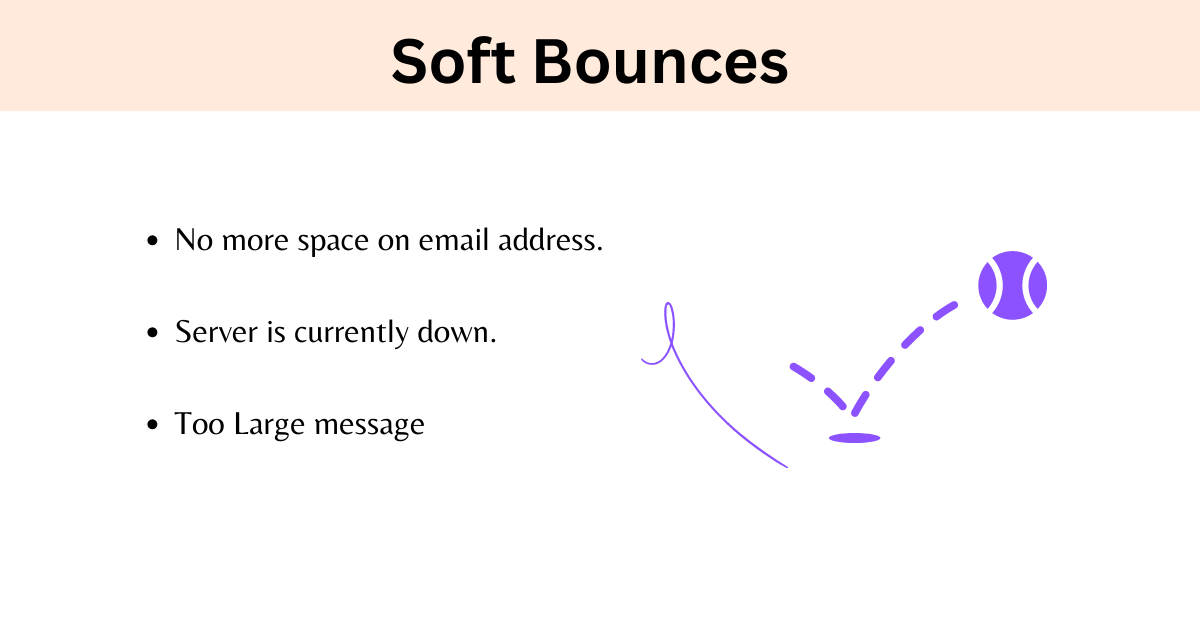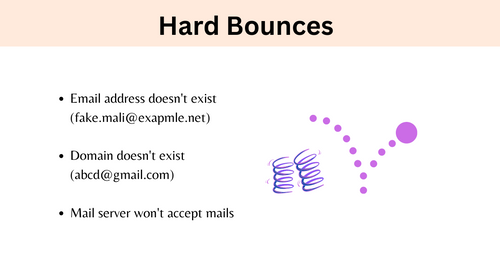Hard Bounces Vs. Soft Bounces – The Ultimate Guide
Hard bounces. Soft bounces. There’s a line between them. However, that line isn’t as clear as you might think.
Let’s start with a general definition of an email bounce.
An email bounce is when an email can’t be delivered to an email address. A hard bounce is a permanent error, meaning that email is no good for the indefinite future. A soft bounce is a temporary error. Some of these can be saved and re-added to your campaign. The others need to be removed from your list completely.
Hard Bounces

What does a hard bounce usually mean? It means an email address doesn’t exist. Here are the two likeliest explanations.
The Email Was Deleted- Maybe a senior executive left his company, and they deleted his email address. Or perhaps an art director deleted her Hotmail address because it was too full of spam. Email addresses are deleted and permanently abandoned all the time. That’s why email list decay happens to every marketer.
The Email Never Existed- This is usually the result of a typo or human error. However, false emails aren’t always accidental. For instance, a poor prospect might give you a fake email address for your lead magnet (if you’re using single opt-in). In rare cases, malicious competitors will degrade your email list with false emails and spam traps. Using double opt-in for your email marketing campaigns will curtail this problem.
Hard bounces are lost causes. They have no upside and plenty of downside. Remove them from your list immediately.
Soft Bounces

Soft bounces are better than hard bounces because it means a prospect may be salvaged. Unlike hard bounces, you still have a chance to communicate with these prospects. Many times a soft bounce is a temporary problem on the recipient’s end.
Inbox Is Full – If your recipient’s inbox is full, they can’t receive messages. A full mailbox is often a sign of an inactive account. However, there are plenty of examples that illustrate the contrary. You can deliver messages to these prospects a few more times, in the hope they’ve cleaned their inbox.
Email Server Down – There are many reasons an ISP goes offline. Sometimes, they are doing maintenance on their server. Other times, their server crashes, is overloaded or is unavailable for an unexplained reason. Once the ISP fixes this short-term issue, you can email your prospect again.
Your Message Is Too Big – If your message is too big, it will soft bounce. For instance, Gmail imposes a sending limit of 25 MB, which is actually quite generous. Remember that pictures and videos take up a lot of space. A single minute of 4K video takes up 130 MB, and 1-2 MB is not uncommon for a photo.
If an email soft bounces too many times, you should treat it as a hard bounce; expunge it from your active list. Moosend recommends sending four times to soft bounces. Don’t resend to soft bounces immediately. Hold on for one or two days. Wait until those full mailboxes are cleaned, and those faulty servers are repaired.
Hard Bounces, Soft Bounces, And Uncertainty

Email servers judge bounces differently. A hard bounce for one ESP may be a soft bounce for another. However, a bounce is a bounce. It means your emails are not getting into the inbox. There are two important bounces that fly under the radar: content bounces and reputation bounces. Sometimes, these fall into the hard bounce category. Sometimes, they fall in the soft bounce category. In any case, we’ll show you how to reduce them.
Content Bounce
ISPs block emails, because spam is a growing issue. As a matter of fact, spam costs American consumers and businesses over $20 billion a year. If your content is flagrant, if it looks like spam, you eventually won’t find your way to the inbox. ISPs want to keep spam down, so they attack spammers aggressively. In the process, they end up with false positives, which stops respectable marketers from getting in the inbox. That’s why you need to disassociate yourself with spammers. Here’s what the ISPs penalize. Avoid these tactics to reduce your bounce rate.
How To Avoid a Content Bounce

- Link to Quality Sites – Linking to a shady site is one of the fastest ways to get a content bounce. Also, don’t use link shorteners in your emails. They are great for sites like Twitter, where character count is of importance. However, in email messages, they make you look like a spammer.
- Balance the Image and Text Ratio – Emails with too many images can damage your email deliverability. First off, some email clients can’t read HTML or images in emails. If the prospect can’t understand your email, you’re not going to convert. Also, emails solely comprised of one big image are suspicious to ISPs. Many marketers use image-text to try and dodge the spam filter. However, the ISPs have caught on.
- Avoid Hashbusting – Certain words can trigger the spam filter. For example – free, fast cash, lowest price, insurance, earn extra cash, pennies per day, etc. Hashbusting is slightly changing the characters of these words to confuse robots. For instance, Free may be written as Fr33. However, ISPs are catching on to these alterations.
- Avoid Deceptive Subject Lines – Open rate is one of the most overrated statistics in marketing. If your subject line is “100% Free $50 Visa Gift Card”, you’re going to get a lot of opens. If you don’t deliver, you’re going to get marked as spam. A strong offer is useless if you betray expectations and trust.
- Avoid Excessive Punctuation in Headlines – Using caps in your email is like shouting. It’s bad manners, and it irritates people. It’s also in poor taste to use excessive punctuation, such as multiple exclamation marks.
Here’s a great way to test content bounces. If a simple message (like Hi) gets through, but your campaign doesn’t, it’s probably an issue with your content. Use the tips above to stop your emails from bouncing.
The Causes of a Reputation Bounce

Your email deliverability is not just about your content. It’s also about your reputation (and the reputation of your ESP). Past performance affects future performance. That means you need to safeguard your email marketing reputation. Here are some critical issues to take note of.
Spam Traps
Not all deleted email accounts disappear into cyberspace. Some of them are repurposed into spam traps. A spam trap is an inactive email address owned by the ISPs. They use these accounts to catch and punish malicious senders. If you email these accounts, ISPs will look askance at you.
There are different kinds of spam traps. There are pristine spam traps and recycled spam traps. A pristine spam trap is created by the ISPs to catch spammers. They appear to be low-hanging fruit, and bot-scrapers pluck them from the tree. However, pristine spam traps are poison fruit to a marketer. Recycled spam traps are abandoned email accounts the ISPs monitor. Pristine spam traps will damage your reputation more than recycled traps, yet both are ominous for your business. An abundance of email spam traps in your list shows you’re not using email best practices.
Blacklists
Ending up on a blacklist is the result of sending too many emails people don’t want to read. Some blacklists only last for a day or two. Other custom blacklists have longer bans. If you’re on a blacklist, you can’t shake, contact the list owner as soon as possible. Responsible blacklist owners like to see initiative.
Purchased Lists
Purchasing email lists is a bad idea. People like birthday surprises. However, people don’t like surprises in their email. People on purchased lists are more likely to mark you as spam. Spam complaints are responsible for up 20% of email deliverability issues. Also, purchased lists are also full of spam traps.
Your ESP’s Reputation
There are many different ESP’s out there. Some of them have a great reputation. Some of them don’t. If your ESP is careless, you’ll be punished. Even if you’re doing nothing wrong yourself.
Email Certifications
Get a Sender Score Certification to improve your deliverability, a process that makes it more likely you’ll get in the inbox of the major ISP’s.
WhiteListing
Whitelisting is asking your subscribers to rubber-stamp your email. That means it will go straight to their primary inbox, as opposed to the spam filter. The more of your email that is delivered, the better your reputation.
Send Regularly
If people forget who you are, they may mark you as spam. Anything less than once per month is too infrequent for business correspondence.
Graymail
People give you permission to email them, but sometimes they lose interest in your emails. This is called graymail. A lot of graymail ends up in the Google Promotions tab. If someone hasn’t opened in a while, try a re-engagementcampaign. If that doesn’t work, email them less, or consider removing them from your campaign. As a marketer, you want to make sure your prospects are engaged.
The Bottom Line About Email Bounces
Soft bounces or hard bounces. Content bounces or reputation bounces. They all mean the same thing: you aren’t getting into the inbox. Use our email best practices to send emails that delight the people on your list, and then, rinse and repeat.
Email bounces damage your sender reputation. If your email bounce rate is above 1%, you have work to do. Email bounce rate is vital. You have prospects who want to hear from you. A high bounce rate puts that communication in jeopardy.
Until we meet again, keep you lists clean !



